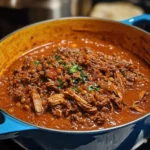Description of this recipe:
Pasta Primavera, meaning “spring pasta” in Italian, is a vibrant and delightful dish brimming with fresh, seasonal vegetables tossed in a creamy, flavorful sauce. This recipe provides a balanced and satisfying meal that is both comforting and healthy. The combination of al dente pasta, crisp-tender vegetables, and a rich, cheesy sauce creates a symphony of textures and flavors that will awaken your taste buds.
Why you will love this recipe:
You’ll adore this Pasta Primavera for its simplicity and adaptability. It’s a fantastic way to showcase seasonal vegetables, making it perfect for enjoying the bounty of spring and summer. The sauce is creamy and flavorful, but not overly heavy, allowing the natural flavors of the vegetables to shine. This recipe is also highly customizable; you can easily swap out vegetables based on your preferences or what’s available in your local market. It’s a comforting yet relatively healthy meal that comes together quickly, making it ideal for busy weeknights or a leisurely weekend lunch. The option to add lemon juice and serve with lemon wedges adds a bright, zesty finish that elevates the dish.
Introduction:
Pasta Primavera is a celebration of springtime produce, transformed into a comforting and satisfying meal. Its origins are often traced back to the Le Cirque restaurant in New York City in the 1970s, where chef Sirio Maccioni and his chefs created a dish to showcase the fresh vegetables of the season. While the original recipe likely involved more complex techniques, the essence of Pasta Primavera remains the same: a medley of perfectly cooked vegetables and al dente pasta enveloped in a luscious sauce.
This recipe captures the spirit of Pasta Primavera, offering a balanced and approachable method for creating this classic dish at home. It begins with a creamy sauce base, elevated by subtle layers of flavor from chicken broth, herbs, and Parmesan cheese. Fresh vegetables are then lightly sautéed to retain their vibrant colors and textures, ensuring each bite is packed with flavor and nutrients. The dish culminates with the addition of the cooked pasta, bringing together all the elements into a harmonious whole.
Whether you are a seasoned cook or a novice in the kitchen, this Pasta Primavera recipe is designed to be easy to follow and rewarding to create. It is a versatile dish that can be adapted to your own personal preferences, making it a delightful addition to your culinary repertoire.
Ingredients:
Sauce:
- 1 ¼ cups chicken broth: Provides a savory base for the sauce. Low sodium is preferred to control salt levels.
- 1 ¼ cups half and half: Lends a creamy richness to the sauce without being overly heavy. Heavy cream can be substituted for a richer sauce.
- ½ chicken bouillon cube: Enhances the chicken flavor of the broth, adding depth and umami.
- 1 teaspoon soy sauce: Introduces a subtle umami flavor and deepens the overall flavor profile of the sauce.
- 1 teaspoon hot sauce: Adds a touch of heat and complexity to the sauce. Adjust the amount to your spice preference.
- ¾ teaspoons EACH: dried parsley, basil, oregano, mustard powder: A blend of dried herbs that provides an aromatic and savory foundation for the sauce. Ensure the herbs are fresh for optimal flavor.
- 1 pinch red pepper flakes: Adds a subtle kick of heat and visual appeal.
Vegetables and Pasta:
- 2 tablespoons olive oil: Used for sautéing the vegetables, providing a healthy fat and enhancing their flavor.
- 2 cups broccoli florets, cut into bite-sized pieces: Adds a crisp texture and a wealth of nutrients.
- ½ cup carrots, julienned: Adds sweetness and a vibrant color.
- ½ cup red onion, sliced: Provides a pungent and slightly sweet flavor that complements the other vegetables.
- 1 cup red bell pepper, sliced: Contributes sweetness, color, and a slightly crunchy texture.
- ½ zucchini, cut into chunks (equal to 1 ½ cups): Offers a mild and slightly sweet flavor with a tender texture.
- ½ cup frozen peas: Adds a touch of sweetness and a pop of green color.
- 1 cup cherry tomatoes, halved or quartered: Provides a burst of fresh, juicy flavor.
- Salt/pepper to taste: Essential for seasoning the vegetables and enhancing their natural flavors.
- 3 tablespoons butter: Used to create a roux with flour, forming the base of the creamy sauce.
- 3 cloves garlic, minced: Adds a pungent and aromatic flavor that complements the vegetables and sauce.
- 3 tablespoons flour: Used to thicken the sauce when combined with butter to make a roux.
- 1 cup freshly grated parmesan cheese: Adds a salty, nutty, and umami-rich flavor to the sauce. Use freshly grated Parmesan for the best flavor and texture.
- ½ lb. ziti: A tube-shaped pasta that holds the sauce well and complements the vegetables. Other pasta shapes like penne, farfalle, or rotini can be used as well.
- 2 tablespoons lemon juice: Adds a bright and zesty acidity that balances the richness of the sauce and enhances the flavors of the vegetables.
Preparation:
Step 1: Prep the Sauce:
In a large measuring cup or bowl, thoroughly combine the chicken broth, half and half, chicken bouillon cube, soy sauce, hot sauce, dried parsley, basil, oregano, mustard powder, and red pepper flakes. Whisk until the bouillon cube is fully dissolved. This pre-mixing ensures that the sauce base is evenly flavored and ready to be added to the roux later. Set the mixture aside.
Step 2: Cook the Pasta:
Bring a large pot of salted water to a rolling boil. The salt enhances the flavor of the pasta. Add the ziti and cook according to package directions until al dente. Al dente means “to the tooth” in Italian, indicating that the pasta should be firm and slightly resistant to the bite. Drain the pasta thoroughly and set it aside. Avoid overcooking the pasta, as it will become mushy when added to the sauce.
Step 3: Sauté Vegetables:
In a large skillet or sauté pan, heat the olive oil over medium-high heat. Add the broccoli florets, red onion slices, carrots, and bell pepper slices. Sauté for 2-3 minutes, stirring frequently, until the vegetables begin to soften slightly but are still crisp-tender. Add the zucchini chunks, frozen peas, and halved or quartered cherry tomatoes. Season the vegetables with salt and pepper to taste. Continue cooking for another 3-5 minutes, or until the vegetables are vibrant in color and crisp-tender. The key is to cook the vegetables quickly to retain their texture and nutritional value. Remove the sautéed vegetables from the skillet and set them aside.
Step 4: Make the Roux:
In the same skillet used for the vegetables (this saves on cleanup and carries over some of the vegetable flavors), melt the butter over medium heat. Once the butter is melted and slightly foamy, add the minced garlic. Cook the garlic for about 30 seconds to 1 minute, stirring constantly, until fragrant but not browned. Be careful not to burn the garlic, as it will become bitter. Stir in the flour and cook for 2 minutes, stirring continuously, to create a roux. The roux is a mixture of butter and flour that will thicken the sauce. Cooking the roux for 2 minutes helps to cook out the raw flour taste.
Step 5: Make the Sauce:
Slowly whisk in the sauce mixture (chicken broth, half and half, etc.) into the roux, whisking continuously to prevent lumps from forming. Reduce the heat to low and simmer the sauce for about 5-7 minutes, or until it has thickened to your desired consistency. The sauce should be creamy and smooth. Stir in the freshly grated Parmesan cheese gradually, whisking until it is fully melted and incorporated into the sauce. Taste the sauce and adjust the seasoning with salt and pepper as needed. Add the lemon juice and stir to brighten the flavor of the sauce.
Step 6: Combine Pasta and Veggies:
Toss the cooked pasta into the sauce, ensuring that all the pasta strands are well-coated. Gently fold in the sautéed vegetables, distributing them evenly throughout the pasta and sauce. Mix until everything is well-combined and heated through. You may need to add a splash of pasta water if the sauce becomes too thick.
Step 7: Serve:
Transfer the Pasta Primavera to serving bowls or plates. Finish with a generous crack of black pepper. Serve immediately while the pasta is hot and the vegetables are still vibrant. Offer lemon wedges as an optional accompaniment for those who prefer an extra burst of citrus.
COOKING Rating:
Easy
Serving Suggestions:
- Serve as a main course for lunch or dinner.
- Pair with a side salad for a complete meal. A simple green salad with a light vinaigrette would complement the richness of the pasta.
- Serve with crusty bread for dipping into the creamy sauce.
- Garnish with additional Parmesan cheese or fresh herbs for added flavor and visual appeal.
Tips:
- Don’t overcook the vegetables. They should be crisp-tender to retain their texture and flavor.
- Use freshly grated Parmesan cheese for the best flavor.
- Adjust the amount of hot sauce to your spice preference.
- If the sauce becomes too thick, add a splash of pasta water to thin it out.
- Feel free to substitute other vegetables based on your preferences or what’s available in your local market.
- This dish can be made ahead of time and reheated, but the vegetables may lose some of their crispness.
- For a vegetarian version, use vegetable broth instead of chicken broth.
- Add protein such as grilled chicken, shrimp, or tofu for a more substantial meal.
Prep Time: 20 minutes Cook Time: 25 minutes Total Time: 45 minutes
Nutritional Information (per serving, approximate):
Calories: 550 Protein: 20g Sodium: 800mg
Conclusion:
This Pasta Primavera recipe is a celebration of fresh, seasonal flavors and textures. It’s a versatile dish that can be easily adapted to your preferences and is perfect for a quick and satisfying weeknight meal or a more elaborate weekend gathering. The combination of al dente pasta, crisp-tender vegetables, and a creamy, flavorful sauce creates a dish that is both comforting and healthy. So, gather your favorite vegetables, get cooking, and enjoy a taste of spring on your plate!
Questions and Answers about this Recipe:
- Can I use different types of pasta? Absolutely! While the recipe calls for ziti, you can easily substitute other pasta shapes like penne, farfalle (bowties), rotini, or even spaghetti. Choose a pasta that you enjoy and that will hold the sauce and vegetables well. The cooking time may vary slightly depending on the type of pasta you use, so be sure to follow the package directions.
- What if I don’t have all the vegetables listed? One of the great things about Pasta Primavera is its flexibility. Feel free to substitute vegetables based on your preferences and what’s in season. Asparagus, snap peas, spinach, mushrooms, or sun-dried tomatoes would all be great additions. Don’t be afraid to experiment and create your own unique version of the dish.
- How can I make this recipe vegetarian or vegan? To make this recipe vegetarian, simply use vegetable broth instead of chicken broth. To make it vegan, replace the half-and-half with a plant-based cream alternative (like oat milk or cashew cream), substitute the butter with olive oil or a vegan butter alternative, and omit the Parmesan cheese or use a vegan Parmesan substitute. You may also want to add nutritional yeast for a cheesy flavor.
- Can I add protein to this dish? Yes, you can easily add protein to make this dish more substantial. Grilled chicken, shrimp, tofu, or chickpeas would all be excellent additions. Simply cook the protein separately and add it to the pasta and vegetables during the final step.
- How long does this dish keep in the refrigerator? Pasta Primavera can be stored in an airtight container in the refrigerator for up to 3 days. Reheat gently in a skillet or microwave until warmed through. Keep in mind that the vegetables may lose some of their crispness upon reheating.




